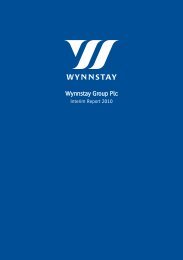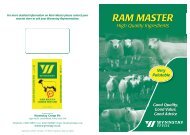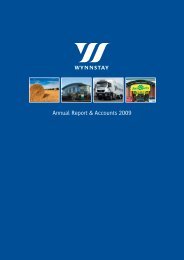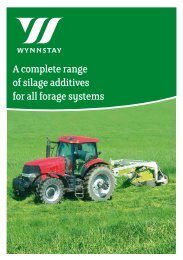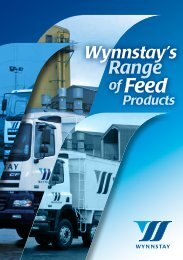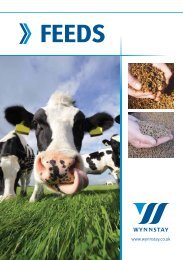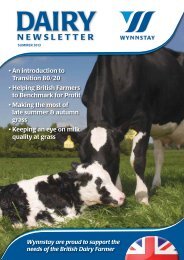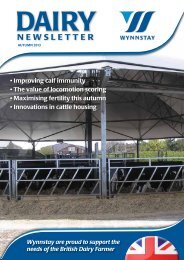Dairy
N e w s l e t t e r - Wynnstay
N e w s l e t t e r - Wynnstay
- No tags were found...
You also want an ePaper? Increase the reach of your titles
YUMPU automatically turns print PDFs into web optimized ePapers that Google loves.
AN OPPORTUNITY TO<br />
IMPROVE YOUR GRASS LEYS<br />
Following a relatively dry start 2012 turned out to be the wettest year on record and no one needs reminding of the<br />
problems that caused. Poached and damaged grass leys were widespread, but this problem will give an excellent<br />
opportunity to introduce some modern day perennials into tired leys, or to carry out a full re seed.<br />
It is common knowledge that reseeding a field will improve yield,<br />
on average by 33%, but there are also many other benefits.<br />
Over several years “weed grasses” will ingress into any sward after poaching<br />
or a hard winter. These “weed grasses” have very poor quality characteristics<br />
compared to modern day perennials, such as poor digestibility (i.e. they do<br />
not convert to meat or milk as efficiently as a perennial) and poor response to<br />
fertiliser. As the Grassland Research Institute at Hurley showed, after 8 years,<br />
more than half the original sown species die out. The benefits that a new<br />
reseed will bring are:<br />
• Improved yields,<br />
• Better diseases resistance especially to crown rust,<br />
• Earlier turnout of stock which will lead to higher stocking rates<br />
• More palatable and digestible (increasing milk and meat production,<br />
improving the animals conditions)<br />
• Improved silage quality<br />
• Improved response to N fertilisers<br />
• Increase margins per head by having lower concentrated feed costs<br />
There is obviously a cost associated with reseeding which is why it is vital<br />
you choose the best grass ley possible, which includes the most modern up<br />
to date varieties.<br />
Once the decision to reseed has been made; following these steps<br />
will help to fulfil the potential of the reseed.<br />
• Destroy the old sward using a product containing glyphosate. Ensure<br />
there is sufficient new growth for the chemical to be taken up and that an<br />
appropriate rate is applied under correct conditions. Whilst this treatment<br />
will control actively growing plants it will not kill dormant seed in the soil.<br />
• Take a soil sample at a depth of 10cm (4 inches) to analyse pH, P and K<br />
indices<br />
• Apply FYM<br />
• Plough and Press<br />
• Apply seedbed fertiliser as required. Apply lime to achieve 6.5 pH at<br />
maximum of 5t/ ha (2t/acre), split-dress if more is required<br />
• Work down to prepare a fine, firm seedbed<br />
• Ring roll<br />
• Choose correct grass mixture<br />
• Drill or broadcast the seed onto the rolled seedbed. Ring roll or light harrow<br />
to ensure maximum contact between seed and soil. Grass and clovers<br />
will not germinate until average daily soil temperatures are above 5ºC.<br />
Temperatures need to rise to achieve satisfactory growth<br />
• Spray with Dursban WG (Chlorpyrifos) if Leather-Jackets or Frit Fly are<br />
expected. Dursban WG may be tank mixed with the glyphosate used to<br />
burn off the old sward to achieve very cost effective control. Remember to<br />
follow the guidelines laid down in the No-Drift Stewardship Campaign<br />
• Once established, graze periodically from 8-12cm (3 – 4 ½ inches) down to<br />
3-6cm (1 – 2 ½ inches)<br />
This will help achieve a densely tillered leafy sward. The removal of grass<br />
allows light to reach and stimulate grass tiller buds and clover growing points.<br />
Sheep or young cattle are less likely to poach the developing sward.<br />
• Weed control in the new ley is usually necessary to ensure good<br />
establishment and to avoid a gappy sward<br />
• If significant weed problems are expected you should consider establishing<br />
the ley without clover and introducing it once a herbicide has been applied<br />
to the sward<br />
If you wanted to inject some life into your older leys, Stitching in is a very<br />
simple but effective way to rejuvenate old or damaged grass leys without<br />
the cost of a complete reseed. Increases in yield and quality can be achieved<br />
without ploughing and the time spent out of production can be reduced.<br />
Stitching in could be the way forward for you. Recent trials work has seen<br />
results from stitching into an existing ley by:<br />
• Increase of yield by over three tonnes of dry matter per hectare<br />
• Increases in D value by 2 points<br />
• Higher Crude Protein; Metabolisable Energy, and sugar contents<br />
For more advice on re seeding, Stitching in and what grass seed mixtures<br />
would suit your management regime please phone Adam Simper in the<br />
seed office on 01939 210777.<br />
Adam Simper<br />
Grass and Root Seed Product Manager<br />
M: 07808 901179<br />
adam.simper@wynnstay.co.uk<br />
Wynnstay Group Plc <strong>Dairy</strong> Newsletter Spring 2013 11



